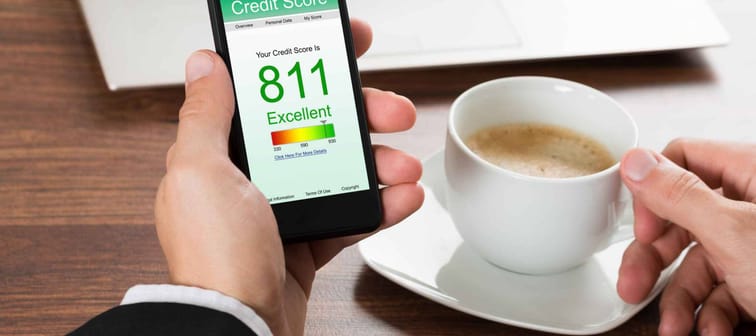What is a good credit score?

You can check your current score online for free using a number of online services. Unlike in the U.S., credit scores in Canada range from 300-900, and break down this way:
-
300-574: Poor. A credit score in this range suggests you’ve had major troubles, like foreclosures or bankruptcy (which can stay on your file for up to seven years). You will struggle to get approved for a standard loan or credit card and will have to fix your score or explore special options.
-
575-659: Low. You may have a history of late payments, have defaulted in the past or may be borrowing as much as you possibly can. Any loans you can take out will have high interest rates tacked on.
-
660-689: Fair. You’ll need to be on the upper end of this range to pass the Canada Mortgage and Housing Corporation’s strict new rules for homebuyers. However, lenders will consider you a moderate risk, so you’ll be locked out of the best rates.
-
690-740: Good. Once your score reaches this stage, lenders will know that you’re trustworthy, granting access to good interest rates and more exclusive credit cards.
-
741-900: Excellent. The top tier of borrowers. With a score this high, you’ll have access to the highest credit limits, the lowest interest rates, rapid approvals and premium credit card perks.
Unexpected vet bills don’t have to break the bank
Spot Pet Insurance offers coverage for treatment of accidents, illnesses, prescriptions drugs, emergency care and more.
Plus, their preventative care plan covers things like routine check-ups, microchip implantation, and vaccinations, if you want to give your pet the all-star treatment while you protect your bank account.
Get A QuoteWhat goes into a credit score?

In Canada, credit scores come from one of two national credit bureaus: Equifax Canada or TransUnion Canada. These private companies collect information about your borrowing history, put that data into credit reports and use those reports to calculate your score.
While the two bureaus have access to slightly different information, meaning your scores from the two sources may differ, they use a similar calculation:
Payment history — 35%
Imagine you let a friend borrow $10. If they paid you back quickly, you’d happily lend money to them again, right? But if you had to shake them down, you’d be more hesitant next time. Companies think the same way and will dock you points if you’re ever late or miss payments.
Credit utilization — 30%
You might think you’re OK because you’re following all the rules and paying on time. However, if you’re constantly keeping a balance close to the limit, you’re hurting your score more than you know.
Credit utilization is the ratio of credit used versus the total credit available to you. So if you’ve racked up $700 of debt on a card with a $1,000 limit, you would have a 70% utilization rate on that card. For the best score, you’ll want to keep your total utilization, across all of your balances, below 30%.
Length of credit history — 15%
Having no credit history is just as bad as having negative credit history. If you’ve never demonstrated your ability to promptly pay back money, lenders will see you as unpredictable and risky. The more history you have to show, the better.
Hard credit checks — 10%
When you apply for a new loan or credit card, lenders will pull your financial records to see if you’re a safe borrower. Too many of these “hard credit checks” in a short period of time suggests you’re scrambling for cash and in a dire financial position. However, you don’t need to worry about “soft credit checks,” when you or someone else checks your history for other purposes.
Credit mix — 10%
Your history with a diverse range of credit types — think car loans, mortgages, student loans, credit cards, lines of credit — can show lenders that you’re experienced and comfortable with the practice of borrowing.
How to increase your credit score

Whether you’re dragging your credit score out of the dumps or trying to make a good score great, the steps to success are the same:
Look for inaccuracies
That’s right: Your lacklustre score could be someone else's fault.
Use a free credit monitoring service like Borrowell to check your credit score and your full credit report. Mistakes do happen, and any errors in your report can drag your score way down. Maybe you were confused for someone else, or an early payment was recorded as late — or maybe you were a victim of fraud.
If something looks off, call the credit bureau that compiled the report right away.
Conquer your debt
The amount you’re borrowing and your ability to pay it back make up 65% of your score, so this is where the real work needs to be done.
If you have the cash in the bank, the quickest way to improve is to pay off debt until your credit utilization ratio drops below 30%. Below 10% would be even better.
A credit monitoring service can help you keep track of payments you might be missing, but anyone struggling with late or missed payments should also consider taking out a debt consolidation loan.
Credit cards in particular can have notoriously high interest rates, sometimes 20% or more. By using a new, low-interest loan to pay off all of your old bills, you can save a ton of money on interest month after month, letting you pay down your debt that much faster.
Time your applications
Too many applications for credit in a short time will raise red flags in your file, so you should only borrow sparingly, when you really need it.
However, if you’re collecting quotes for a mortgage or a car loan, the Government of Canada recommends doing all of your shopping within a two-week period, so multiple hard credit checks are compiled into one.
Don’t close paid-off cards
You might find it counterintuitive to keep credit cards active when you’re not using them, but even old cards collecting dust in a drawer can be beneficial.
Having an old card on file shows that you have a history of properly settling your debts — though you’ll want to make sure the card doesn’t have a monthly or annual fee.
If you’re just starting to build credit in Canada and don’t have any history, a secured credit card might be the way to go.
Secured credit cards are easy to get but have lower limits and require you to make a deposit up front as collateral. Think of it as a trial run for a full-fledged card, but your good behaviour will be reported to credit bureaus all the same.
Trade Smarter, Today
Build your own investment portfolio with the CIBC Investor's Edge online and mobile trading platform and enjoy low commissions. Get 100 free trades and $200 or more cash back until March 31, 2025.








